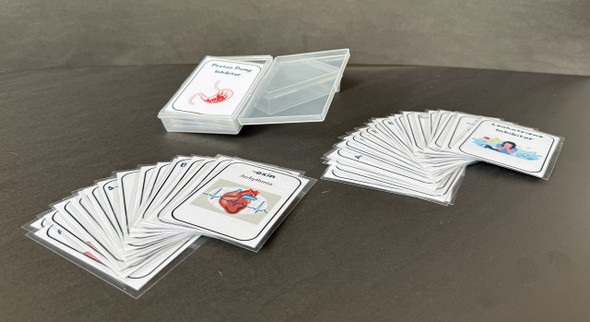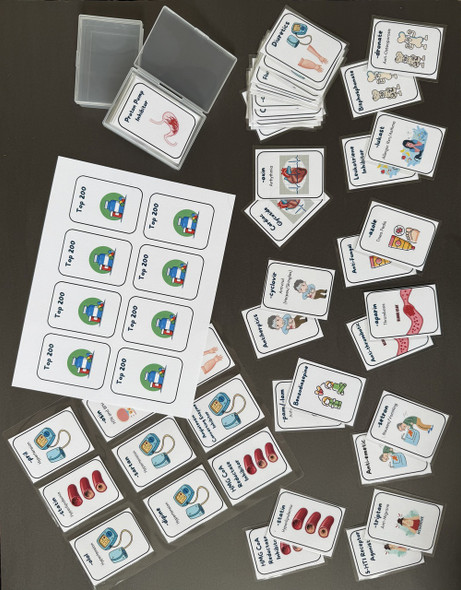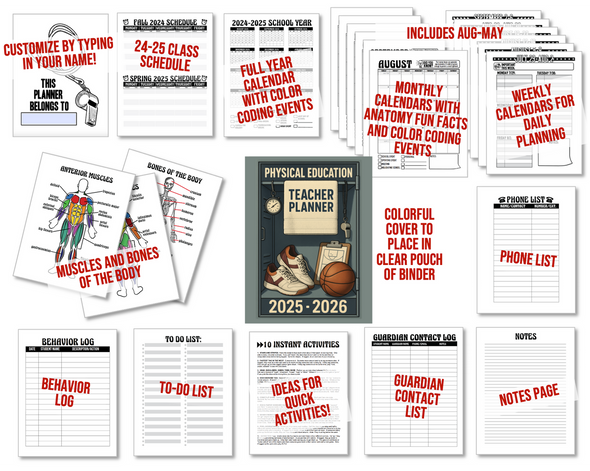Description
Knowing the Top 200 commonly prescribed medications, and the disease they treat, is a foundation in the practice of pharmacy. Being familiar with common drug prefix/suffix and associated drug classes makes learning Brand/generic names MUCH easier!
Want to get the Card Deck shipped to you? All the cutting and laminating done for you? - Get it Here
Players need to find matches between drug prefixes/suffixes with their respective drug classes/diseases. Participants test their knowledge of pharmacology and medicine while learning about drug mechanisms and therapeutic targets. This set of cards (64 cards with 32 pairs) can be used with any "matching style" game and brings out the competitive nature of our students. This can be played individually or in groups.
How to Play: Go Fish Style
Number of Players: 2 to 6 players.
Objective: The goal of Pharm-a-Pair is to collect as many "sets" of cards. The student must be familiar with the associations so they know what to ask for from the decks of the other players.
Deck: Use the 64-card Pharm-a-Pair deck
For 4 or more players, each player gets 5 cards.
The remaining deck is placed face down as the draw pile.
How to Play:
Forming a Set: As you collect cards that pair up, you can place sets face up in front of you. Each time you complete a set, you score one point.
End of the Game: The game ends when either all pairs of cards are matched or the draw pile is empty. The player with the most sets of pairs wins.
Objective: The goal of Pharm-a-Pair is to collect as many "sets" of cards. The student must be familiar with the associations so they know what to ask for from the decks of the other players.
Deck: Use the 64-card Pharm-a-Pair deck
Dealing:
For 2-3 players, each player gets 7 cards.For 4 or more players, each player gets 5 cards.
The remaining deck is placed face down as the draw pile.
How to Play:
Player's Turn: On your turn, ask any other player for a specific card. For example if you are holding -olol, you would ask for Beta Blocker and the picture would remind you that the medication is associated with blood pressure.
Receiving the Cards:
If the player you ask is holding the requested card, they must give it to you. You then get another turn and continue asking for cards.If the player does not have the requested card, they say "Go Fish," and you must draw a card from the draw pile.
If the card you draw is the match you requested you get another turn. If not, your turn ends.Forming a Set: As you collect cards that pair up, you can place sets face up in front of you. Each time you complete a set, you score one point.
End of the Game: The game ends when either all pairs of cards are matched or the draw pile is empty. The player with the most sets of pairs wins.
How to Play: Concentration style
Make sure there’s an even number of cards so that every card has a matching pair.
If the cards match (e.g., -olol and Beta blocker), they keep the pair and take another turn.
If the cards don't match, they flip them back face down, and it's the next player's turn.
The player with the most pairs at the end wins the game.
Setup:
Shuffle the deck of cards and lay them face down in rows.Make sure there’s an even number of cards so that every card has a matching pair.
Turn Sequence:
On each player's turn, they flip over two cards.If the cards match (e.g., -olol and Beta blocker), they keep the pair and take another turn.
If the cards don't match, they flip them back face down, and it's the next player's turn.
Winning:
The game continues until all pairs have been matched.The player with the most pairs at the end wins the game.
How to play: Headband Style
Note: You need to start with an even number of students so that pairs can be formed. If uneven, the instructor can join in and model for students how to phrase questions. I went to our local "5 Below" and bought generic headbands games so I have plenty of headbands. This game really gets the students thinking scientifically and using all those "big words" that we've taught them.
Setup: Each player takes a headband (or something to attach the card to) and the instructor sticks the prefix/suffix or matching drug class card to the students headband. The card must face the other players, so the person wearing the card cannot see it. The student does not know what card has been placed.
Gameplay:
Players mingle around take turns asking yes/no questions to figure out what prefix/suffix or drug class is on their card.For example: "Do I treat a disease in the brain?" "Do I treat hypertension?" "Do I have side effects?""Am I a drug class?""Am I a prefix/suffix?"
Other players can only respond with "yes" or "no."
Guessing: The player continues asking questions until they think they have identified their card and attempt to find their match. Once together, and paired correctly which is confirmed by the instructor, that is the winning team. You can continue the game and have a 2nd and 3rd place winner. As groups are formed it will be easier for the reminder of the students. I have them keep asking questions until all matches are made.
Winning: The first team to correctly pair up wins that round. You can either continue playing in rounds or keep score based on how many times a student was able to find their match (without cheating
Optional Rules:
You can set a time limit for each round (e.g., 1or 2 minutes) to keep the pace fast and fun.
JPEG CARDS INCLUDED - Since some printers don't print double sided (multiplex) and there could be issues with alignment, I have included individual jpegs. The user should print 8 copies of the card backing file on card stock. Follow up with printing the prefix/suffix and disease/drug class on the opposite side of the card stock.











